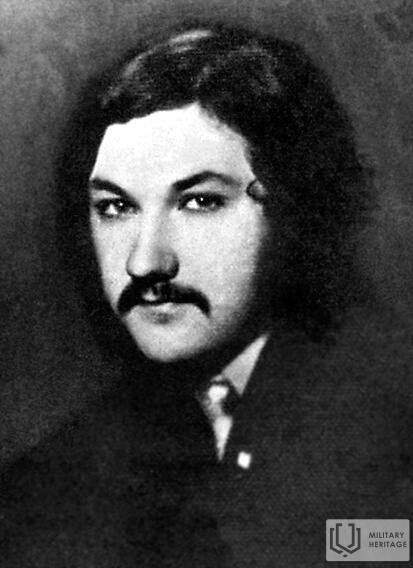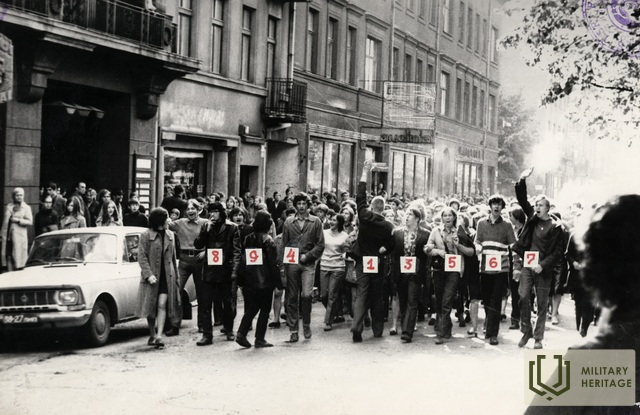1972 – The Sacrifice of Romas Kalanta
IV Soviet Occupation
The Soviet regime was opposed in various forms. Sometimes the action or sacrifice of one person grew into large waves that caused considerable concern for the Soviet system. Such was the story of Romas Kalanta.
Romas Kalanta (1953–1972) was born in Soviet-occupied Lithuania. Romas' father fought in the ranks of the Soviet 16th Lithuanian Division during World War II and was a member of the Communist Party. Romas' mother is said to have been quite religious and sought to raise her children in the Catholic spirit. Kalanta could have chosen a quiet life as a Soviet citizen, but he chose a different path. In 1971, he was supposed to graduate from high school in Kaunas. However, he failed the chemistry, geometry, and physics graduation exams and did not finish school. It is mentioned elsewhere that he failed the history exam because he did not adhere to the mandatory Soviet dogmas of its interpretation. That year, he was also expelled from the Komsomol. Kalanta switched to evening school and worked in a factory. His characteristics at that time indicate that he was slow, peaceful, rather reserved, liked to analyze, not inclined to openly make friends, that he was well-read, wrote poems, played sports, and played the guitar. He liked the music of The Beatles. It is believed that he belonged to or sympathized with hippies - he had a corresponding appearance, grew long hair. The young man did not hide the fact that he was a practicing Catholic.
On May 14, 1972, at noon in the garden of the Musical Theatre in Kaunas, Kalanta doused himself with petrol and set himself on fire, shouting “Freedom for Lithuania!”. The doctors’ efforts to save Kalanta’s life were unsuccessful, and he died in hospital at 4 a.m. the next day. The last entry left in the nineteen-year-old’s notebook was “Only the regime is to blame for my death.” It was a protest against the Soviet regime.
The local communist authorities and Soviet security structures, faced with an unprecedented case, took measures. They forced Kalanta's funeral, which took place on May 18, to be brought forward by two hours to avoid gatherings. And he was buried in a different cemetery than the relatives had planned. However, this provoked the events known as Kaunas Spring. The crowd of young people who had gathered for the funeral towards Kalanta's house turned to Kaunas's Laisvės Avenue. According to KGB reports, over 3,000 protesters took to the streets during the two-day unrest. Over 7,000 Draugovinians, militiamen and soldiers were deployed to suppress them. Special military units of the Lithuanian SSR Ministry of Internal Affairs were sent to Kaunas. Clashes between demonstrators and soldiers took place. This was one of the largest actions of resistance to the Soviet system in the history of the Soviet Union before the beginning of Perestroika. True, in addition to the Kaunas Spring of 1972, the events of the All-Day Parade in Kaunas in 1956 are also worth remembering, which attracted an even larger crowd of thousands. In 1972, the protests spread to other Lithuanian cities, where 108 people were arrested. The initiators of these events, masking their political overtones, were convicted as hooligans and “asocial elements” under the guise of “fighting hippies”. Kalanta was officially recognized as mentally ill. For eight years, Kalanta’s parents were not allowed to erect a tombstone on their son’s grave.
In those days in 1972, Romas Kalanta became a national hero. He is still considered such today.
More information sources
- Arvydas Anušauskas, “KGB reaction to the events of 1972”, in: Genocide and resistance , 2003, no. 1(13), 80–83, available online: https://etalpykla.lituanistika.lt/fedora/objects/LT-LDB-0001:J.04~2003~1367184458129/datastreams/DS.002.0.01.ARTIC/content .
- Vilma Juozevičiūtė (ed.), "Romas Kalanta", in: Lithuanian Population Genocide and Resistance Research Center , available online: https://www.genocid.lt/UserFiles/File/Atmintinos_datos/2014/04/201404_kalanta_biog.pdf .
- Žydrūnas Mačiukas, Angonita Rupšytė (eds.), "1972 - the victim of Romas Kalanta and the resistance of youth", in: Seimas of the Republic of Lithuania , available online: https://www.lrs.lt/sip/portal.show?p_r=37029&p_k=1&p_a=1000&p_kade_id=10 .






